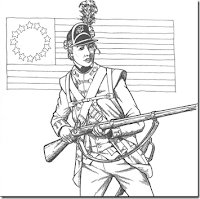Robert Shurtliffe fought on the side of the Rebels in the American Revolution. This was after having walked 30 miles to sign up in the 4th Massachusetts, a light infantry unit of the Massachusetts Line. Taller, at 5' 8”, than the average man of that time, Robert had developed broad shoulders and a muscular body through years of laborious farm work.
In 1782, the 4th Massachusetts was stationed at West Point in New York. It was guarding the Hudson River Valley against units of Loyalist Americans who still hoped to achieve the British goal of detaching New England from the rest of the colonies.
In one battle, Shurtliffe took a saber cut across the left side of the head and tended it without medical assistance. A few weeks later Robert was hit in the thigh by a musket ball. Once again, self-treatment was used, trying --- unsuccessfully--- to dig the ball out with a pocket knife.
More medical trouble followed. Shurtliffe suffered a severe brain fever, which was not uncommon among rebel soldiers, given the dreadful conditions in which they lived and fought.
The result was that, after a year and a half of service, Robert Shurtliffe was honorably discharged and sent home with letter of testimony to gallantry in combat.
Massachusetts awarded the veteran a pension which eventually rose to $8 a month. A few years later, then-President George Washington invited the gallant ex-soldier to visit the capital. A highlight of the visit was that Congress passed a bill granting veterans such as Shurtliffe a national pension and grants of land.
At the urging of Paul Revere, Shurtliffe went on tour in 1802, appearing on stage to give first-hand accounts of wartime experiences.
Robert Shurtliffe died at age 68 in 1827. It should be noted however, that the veteran was not buried under that wartime name. That was because, while the unconscious soldier was being treated for that brain fever back in 1783, the attending doctors had discovered that Robert Shurtliffe was really a 23-year-old woman named Deborah Samson.
After the war, Deborah married a farmer named Benjamin Gannett and bore him three children. But she could not have imagined, I think, that it would be nearly a century after her death before her great great granddaughter would be the first female in her line to be allowed to vote.
How did the U.S. go from a land in which a female had to masquerade as a man in order to do what a man could do to one in which a person of the same gender could exercise such an important aspect of the freedom for which Deborah Samson had exposed herself to danger, pain, and privation?
That's in no small part because in the intervening decades Americans had always had before them the ideals which Thomas Jefferson had written into that Declaration of Independence which we honor today:
“We hold these truths to be self-evident: that all men are created equal; that they are endowed by their Creator with certain inalienable rights; that among these are life, liberty, and the pursuit of happiness; that to secure these rights, governments are instituted among men, deriving their just powers from the consent of the governed; that whenever any form of government becomes destructive of these ends, it is the right of the people to alter or to abolish it, and to institute new government....”
Enjoy your holiday today by keeping in mind the reason for which we celebrate.
Thanks, Dad, for once again reminding us of all that is good about this country!

No comments:
Post a Comment